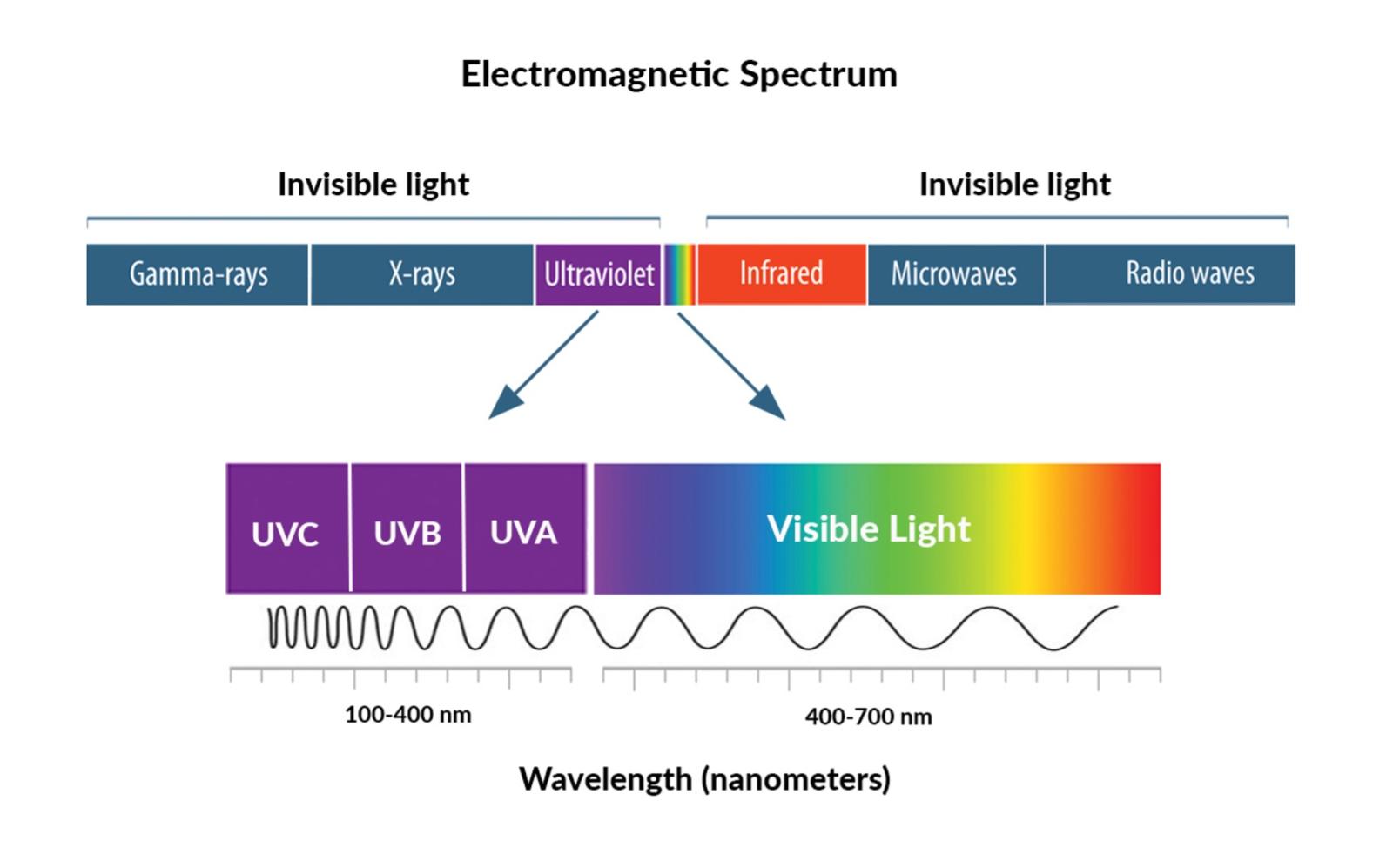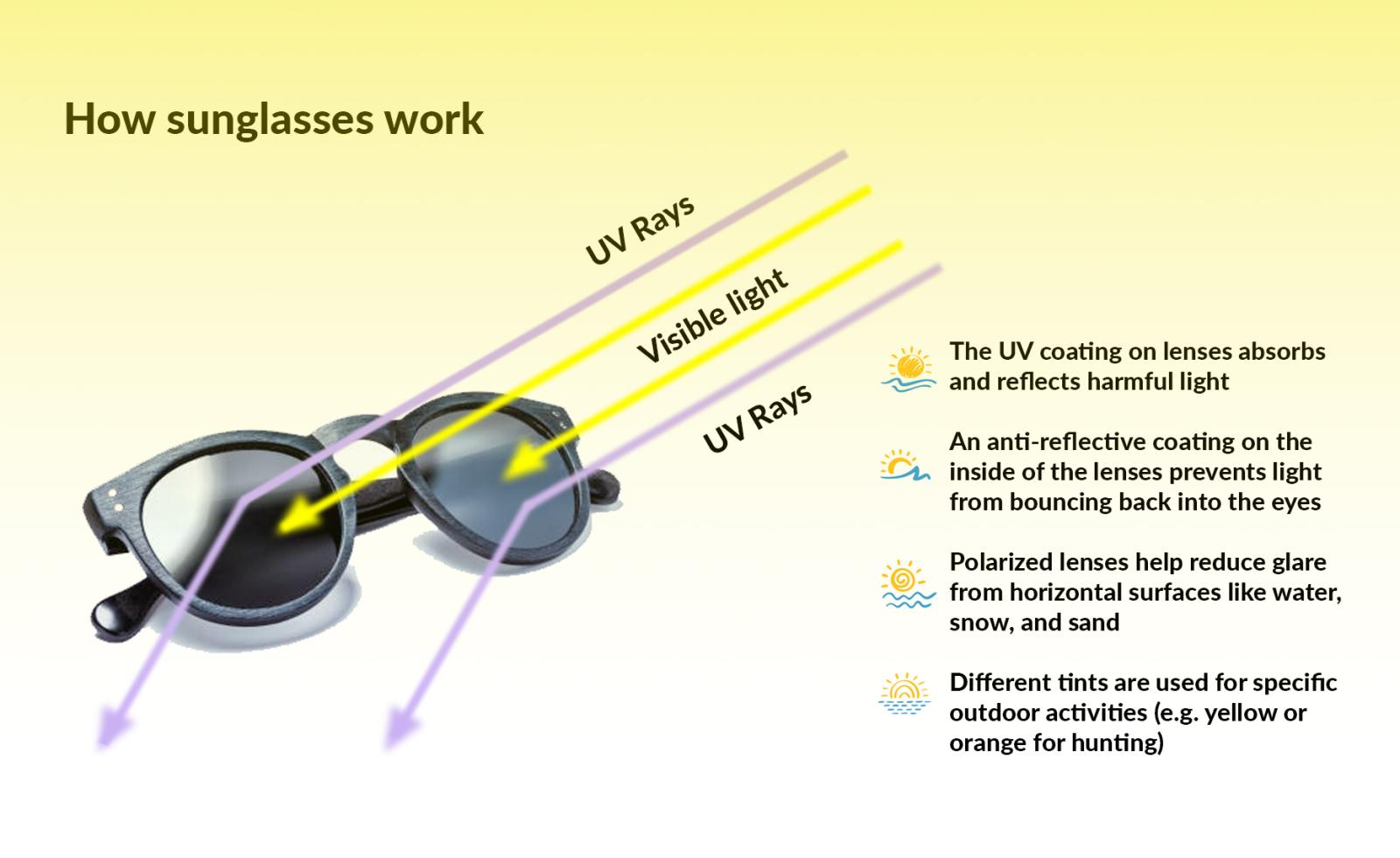Everyone loves fun in the sun. We all know that too much sun causes skin damage. But did you know its ultraviolet (UV) rays can also damage the eyes? Here are some common questions and answers about UV light and how to protect your eyes from the sun.
Q: What is UV light?
UV light is a form of electromagnetic radiation. It is invisible to the human eye because of its very short wavelength. Only a very small portion of the electromagnetic spectrum is visible to the human eye as light.
There are three types of UV light, based on wavelength range. UVA wavelength is 315 to 400 nanometers. UVB is 280 to 315 nanometers, and UVC is 100 to 280 nanometers.

Within the spectrum of visible and invisible light, just a small portion can be seen by human eyes. UV light is not visible. Credit: NEI
Q: Why do I need to protect my eyes from UV light?
UV light more easily penetrates eye tissues than visible light, potentially increasing the risk of eye problems.
Among the three types of UV light, UVA emits the least energy but can cause aging of the skin. Wrinkles and “sunspots” are some of the most common long-term effects of UVA, but it is also linked to some skin cancers.
UVB emits slightly more energy than UVA. UVB damages DNA directly and is responsible for sunburns and most UV-related cancers.
UVC emits more energy than UVA and UVB but is mostly blocked by the Earth’s ozone layer. Aside from the sun, UVC comes from welding torches and UV sanitizing bulbs. It more easily penetrates the skin, potentially damaging skin cell DNA and increasing skin cancer risk.
Q: How do I protect my eyes from UV light?
Wearing sunglasses and a hat is the simplest and safest way to protect your eyes from UV rays. Choose sunglasses that that fit well and that block light from coming in around the lenses. Choose a hat with a broad, dark brim that shades your eyes and reduces glare.
Consider staying indoors during parts of the day when the sun is strongest, usually between 10 a.m. and 4 p.m. Check your local weather forecast for the UV index, a measure of UV intensity. Be aware that the UV index can be high even on cloudy days.

Images of eyes with a pinguecula (top) and a pterygium (bottom). Image source: American Optometric Association
Q: What eye problems are linked to UV light exposure?
Several eye problems are linked to UV exposure.
A pinguecula is a protein and fat deposit in the white part of the eye (sclera). It can cause irritation and, in rare cases, affect how tears cover the eye.
A pterygium (Surfer’s Eye) is a growth that extends from the sclera to the clear tissue called the cornea, which covers the iris and pupil.
A cataract is a cloudy area in the eye’s lens. Prolonged exposure to UV rays modifies lens proteins, leading to cataract formation and worsening eyesight. Over time, cataracts can make vision blurry, hazy, or less colorful.
Cancers of the eyelid, including basal cell carcinoma and squamous cell carcinoma, are linked to UV exposure. No link has been made between UV exposure and other types of ocular cancers.
Age-related macular degeneration (AMD) blurs central vision due to the breakdown the macula — the part of the eye that controls sharp, straight-ahead vision. The macula is part of the light-sensitive retina in the back of the eye. Some studies indicate prolonged exposure to UV rays without protection increases the risk for AMD.
Q: How can I protect my children’s eyes from UV?
Sunglasses are available in many sizes, including kids' sizes. But sunglasses may not be practical for all kids. A hat may be a more practical solution.
Q: How do sunglasses work?
All sunglasses work by blocking and/or reflecting the harmful UV light away from the eyes.
Q: How do I choose a pair of sunglasses?
UV-blocking lenses are the most important feature of all sunglasses but should not be the only one to be considered when buying a new pair.
Consider the following factors when choosing sunglasses:
- Lens material. Sunglasses lenses can be made from a variety of materials, including plastic or polycarbonate. By law, retailers must indicate level of UV protection. Look for lenses that provide 99 to 100 percent protection from UVA and UVB or marked as having a UV400 rating. The U.S. Food & Drug Administration (FDA) regulates non-prescription sunglasses as medical devices. It requires that manufacturers and retailers meet minimum requirements for UV protection, lens quality, impact resistance, labeling, and more. Unsure if your sunglasses have UV-blocking lenses? Many optical shops have a device called a photometer to test them.
- Fit. Choose comfort over style when selecting sunglasses frames. They should feel good, stay in place, and cover the skin around your eyes. A good fit will minimize light that enters the eye from the top, bottom, and sides of the lenses.
- Use. Choose sunglasses according to your activity. Activities near water, snow, sand, and other reflective surfaces increase UV exposure by reflecting light. Polarized lenses are good for reducing glare from snow or water. Consider wearing wraparound sunglasses or goggles to protect yourself from intense light or when doing yardwork or other activities that create flying debris.

Image credit: NEI
Q: Should I avoid cheaper sunglasses?
Don't assume that expensive, designer sunglasses provide better UV protection than sunglasses available from grocery stores or discount vendors. Only buy sunglasses that are clearly marked as providing 99 to 100 percent protection from UVA and UVB or marked as having a UV400 rating.
Q: Do contact lenses provide UV protection?
Some contact lenses block UV. Wearing UV-blocking sunglasses over your contact lenses will help protect the skin around your eyes as well the portion of your eyes that contact lenses don’t cover.
Resources:
1. American Optometric Association (AOA): Ultraviolet (UV) protection
2. Food and Drug Administration (FDA) - regulates nonprescription sunglasses as medical devices: Sunglasses, Spectacle Frames, Spectacle Lens and Magnifying Spectacles
3. All About Vision – guide to choosing high-quality sunglasses: https://www.allaboutvision.com/sunglasses/quality-buyers-guide/
4. Check the daily UV Index from the National Weather Service: https://www.cpc.ncep.noaa.gov/products/stratosphere/uv_index/bulletin.txt